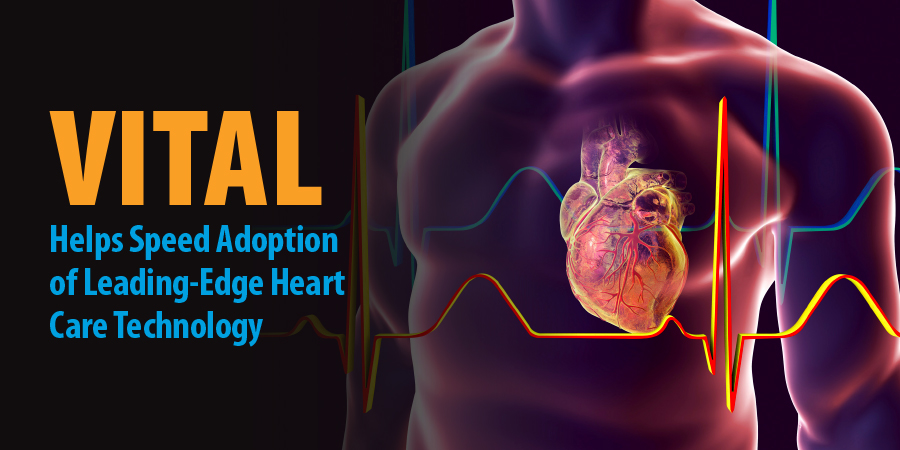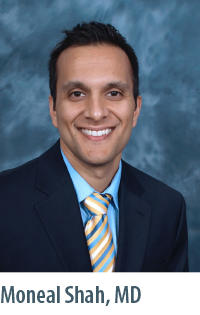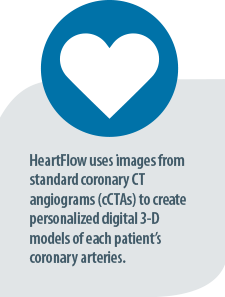

 Three years ago, cardiologist Moneal Shah, MD, of Allegheny Health Network (AHN) had heard about a groundbreaking new non-invasive, diagnostic technology called HeartFlow®.
Three years ago, cardiologist Moneal Shah, MD, of Allegheny Health Network (AHN) had heard about a groundbreaking new non-invasive, diagnostic technology called HeartFlow®.
Approved by the U.S. Food and Drug Administration (FDA), HeartFlow uses 3-D computer modeling and highly advanced software to diagnose a patient's coronary arterial blockage and how it affects blood flow.
"In the beginning, when I heard about HeartFlow, I wanted to talk to my division chief, Dr. Srinivas Murali, about exploring it," said Dr. Shah, AHN's co-director of Cardiovascular MRI. "But then I heard that Highmark Health and VITAL  were already talking to HeartFlow, which is a company from California."
were already talking to HeartFlow, which is a company from California."
Dr. Shah got involved in the conversations. "They needed a physician champion to put HeartFlow to the test, and I expressed interest," he said.
Soon, Dr. Shah and his colleagues were putting HeartFlow through its paces at AHN facilities — learning firsthand how the new technology could make heart care safer, smarter, and less expensive for patients.
VITAL is a program of Highmark Health that provides the missing link between FDA approval of a new medical technology and its reimbursement by Highmark and, potentially, as part of a planned expansion, other commercial insurers. VITAL's overall goal is to make leading-edge technologies and treatments available sooner for patients.
When doctors or other industry partners identify a potential new treatment, technology, or procedure, VITAL offers support that helps them gain insights and collect the needed data to demonstrate the effectiveness of the innovation. VITAL collects evidence of clinical quality, financial feasibility, and patient experience to make a case for adopting the new solution within the care delivery system. That information helps to explore opportunities for care management programs and changes to coverage and reimbursement policies. And that can give patients faster access to new, promising treatments.*
Support from VITAL enabled Dr. Shah and his colleagues at AHN to launch a HeartFlow pilot project Jan. 1, 2016. And from the very start, they saw the revolutionary impact the technology would have on diagnosing and treating heart blockages.
 HeartFlow uses images from standard coronary CT angiograms (cCTAs) to create personalized digital 3-D models of each patient’s coronary arteries. Using advanced computer algorithms to solve millions of complex equations, the technology determines a “fractional flow reserve” for all the arteries, which assesses the impact of blockages on blood flow.
HeartFlow uses images from standard coronary CT angiograms (cCTAs) to create personalized digital 3-D models of each patient’s coronary arteries. Using advanced computer algorithms to solve millions of complex equations, the technology determines a “fractional flow reserve” for all the arteries, which assesses the impact of blockages on blood flow.
This information helps physicians decide the best treatment for each patient.
"Prior to HeartFlow, no single non-invasive cardiovascular test offered both anatomic and functional heart information simultaneously," said Dr. Shah, who serves as lead investigator on the project. "CT alone can show a blockage but not how significant it is or if it impairs blood flow. A stress test alone gives us functional information but not anatomical insights."
Conversely, HeartFlow offers the full anatomical and functional picture of the heart and can eliminate the need for multiple tests.
"It's totally new and unprecedented," Dr. Shah added. "It gives us a clear map of the coronary tree. It's a huge leap from the kind of information we used to get from a non-invasive test. And HeartFlow can let us know whether the patient needs additional tests or procedures."
 To date, roughly 100 AHN patients have been assessed and diagnosed using HeartFlow. Although data are still being gathered, the pilot project offers evidence of the new technology's positive impact on patient care — a primary driver of VITAL's mission.
To date, roughly 100 AHN patients have been assessed and diagnosed using HeartFlow. Although data are still being gathered, the pilot project offers evidence of the new technology's positive impact on patient care — a primary driver of VITAL's mission.
For example, HeartFlow reduced unnecessary angiograms by over 83%. And, on average, overall care costs were reduced by 48%, which also lowered patients' out-of-pocket expenses.
"Any time we can prevent unnecessary procedures, especially invasive procedures like heart caths, that reduces risks for the patient," Dr. Shah said. "The associated health care savings also are a plus."
He recalls a 63-year-old female patient who exemplifies HeartFlow's positive impact.
"She had an abnormal stress test and was going to be having a heart cath," Dr. Shah said. "She was very anxious, not only for the test itself, but also because she had to take care of her elderly mother and didn't want an overnight hospital stay."
So HeartFlow was used, and it showed no need for the heart catheterization. "It was a huge weight off of her mind," Dr. Shah said.
Conversely, HeartFlow has surprised physicians by showing the need for invasive intervention. "We saw one patient who had a normal stress test but was still having symptoms," he said. "HeartFlow revealed the patient had a significant blockage. So it's allowed us to be more thorough and more precise."
Upcoming HeartFlow advancements are expected to make the technology even more useful.
"Just like with other technology, HeartFlow is advancing and adding more capabilities," Dr. Shah said. "They are developing simulation technology that will let us virtually place a stent and see how much better blood flow gets to determine if stenting will be helpful. It's called virtual stenting."
Getting HeartFlow into the patient care environment at AHN likely would have taken longer — potentially two to three years longer — without support from VITAL, Dr. Shah noted.
"VITAL was instrumental because, originally, I thought I'd have to convince my administration to adopt HeartFlow," he said. "For me, as one person, it might have been very challenging to make the case for it.
"But to have the backing of VITAL and their support in the pilot made it much easier," Dr. Shah said. "VITAL gave us the perfect avenue to put this technology into practice."
And, based on the results of the pilot, health insurers will realize how HeartFlow can benefit patients and the health care system.
"One of the reasons that Medicare approved HeartFlow for coverage was the evidence we generated from the VITAL pilot, which took about two years," Dr. Shah said. "And once Medicare approves something, a lot of other payers take notice."
As of Feb. 1, 2018, Highmark began covering HeartFlow.*
Dr. Shah highly encourages other clinicians to reach out to VITAL if they've identified a promising new medical technology or treatment that may make a difference for patients.
"VITAL is looking for good ideas and new technology to test in a real-world environment," he said. "Working with them has been a very rewarding experience."
For more information or to begin an application, visit vitalinnovationprogram.org  or send an email to VITAL@highmarkhealth.org.
or send an email to VITAL@highmarkhealth.org.
*The coverage of any medical service or treatment is subject to the terms of the member's benefit plan. Please be sure to use NaviNet® or the applicable HIPAA electronic transactions to check member benefits and eligibility prior to ordering or providing services.